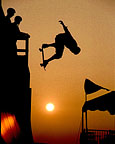











The Friedman Archives Newsletter
January 2009
In this issue:
Sony's New Wireless Flash Protocol
I'm working steadily on the new Alpha 900 book - it will be about 85% new content, including a massive update to the chapter on wireless flash, so the process is taking a good long time (but I promise the result will be worth the wait). It seems that, with the introduction of the 58 flash, Sony has completely revamped the wireless flash protocols -- the time between pre-flash and exposure has been shortened, and more addressing capabilities have been added. The result? Automatic Ratio mode has returned (this feature worked with film cameras brilliantly, but was disabled in digital bodies for technical reasons), and now you can control up to 3 banks of flashes (well, sort of) from the rear of the 58.
Okay, but how does it work, and how much of it is backwards-compatible with the Minolta / Sony 56 and 36 flashes? Can you mix and match the 56/36 and 58/42 flashes?
Reading Sony's documentation to learn the answers to these basic questions can be a frustrating experience. (In Sony's defense, it wouldn't have been nearly so complicated had Sony not tried to be backwards-compatible with their older 56 and 36 flashes.) So here's a summary of some basic truths that are essential to know if you are going to be using wireless flash with the A900 and the 58 as the wireless flash controller:
The basic wireless flash protocol has been completely revamped and is incompatible with the older system. That means if you set a 58 on top of an A900 or A700, it won't be able to trigger your 36 or 56 out of the box. (Or at all if mounted on any other camera.) Sony calls this new, incompatible system "Control +" and is the factory default.
The older protocol is simply called "Control", and is required to trigger the 36 and 56 flashes. Only the A900 allows the 58 to work using this mode.
As wireless slave flashes, the 58 and 42 work just swimmingly whether they're being triggered by a pop-up flash from a Maxxum 7 (old protocol which used HSS; older cameras won't work) or by a 58 in "Control+" mode. Just set them to wireless mode and let them go.
However, if you want to use the older 56 or 36 flashes as a slave, you have to put the A900-mounted 58 into the "Control" mode (so it sends the old protocol). To do this, set the 58's Custom Function 3 to "CTRL2".
So all these modes and compatibility issues might seem a little daunting, so here's something to make it clearer. Below is a diagram showing the simplest configuration possible for wireless flash:

Notice that with this configuration, illumination for the subject comes only from the slave flash. (The Master only sends out Morse-code-like commands using weak flash pulses, and doesn't affect the exposure significantly.) And the 58 has been put into the old-protocol "CTRL" mode so it can readily trigger any wireless flash you may have (36, 56, 42, or 58).
Next, let's talk about groups and ratio flash. First, here's a quick recipe for ratio flash:

(Things don't look so intimidating in diagrams, do they?) This setup is identical to the previous diagram, except that "Ratio" mode on the 58 has been enabled. In this mode, light to illuminate the subject comes from both the slave as well as the master, and you can control the proportions from the back of the Master. Dialing in a ratio of 1:4, for example, means that the slave outputs four times as much light as the master.
Finally, let's figure out what's involved to achieve Sony's Marketing claim of "Up to three groups of flashes can be set up for optimal, complete control of lighting via a wireless connection". Here's how to do it:

With this setup, illumination comes from all three flashes (plus the control signals from the master, which don't affect exposure significantly). Here are the salient points about this setup:
The Master flash was put into "CTRL+" mode (by setting Custom Function 3 to "Ctrl1").
The new flash added to the bottom can ONLY be another 58 flash, as the 58 is the only flash on the planet that knows what RMT2 (Remote 2) mode is.
The rightmost flash can ONLY be a 42 or a 58 - none of the legacy flashes will respond when the master is set to "CTRL+".
Notice that Sony treats the Master flash on top of the A900 as a "Group". (!)
So now, dialing in a flash ratio of 1:2:8 means that the RMT flash is twice as bright as the light from the master, and the new RMT2 flash is 8 times as bright as the master. Don't want light coming from the master? Then you can dial in "-:2:8" and the Master will only put out control signals.
Flashes literally become groups when you have more than one configured the same way:

So that's the new wireless flash in a nutshell. Now that the basics have been laid out for you, you can now go back to that cryptic flash manual of yours and figure out how to set CF3 and ratio modes (or just buy my book when it comes out :-) ) and the rest of it should make a great deal more sense, too!.
(NOTE: You can be notified when the A900 book is ready by registering your interest via email.)
A Mime is a Terrible Thing to Waste
Reader Zulia Arbon, a Tajikistan citizen who's been living in China for 7 years, writes in with this question: "You took quite a few photos of people in China. How did you get around this? Did your translator help you to ask those people for permission to take pictures? Has anyone minded? Were there any times when you weren't allowed to take photos? I quite often see some really peculiar moments here in China, and I took some lovely photos. But sometimes I just don't have enough courage to ask people if I can take photos of them."
Dear Zulia,
Thanks very much for your email, and let me start my answer with a story. Many years ago I attended a Cirque du Soleil performance, and I witnessed a most remarkable act -- a mime was grabbing volunteers from the audience and, using only his body language and without uttering a word, started directing them as if he were directing actors in a movie. After 15 minutes the audience members knew their lines and roles, and were ready to perform a one-minute skit in front of his imaginary movie camera!! This taught me an incredible lesson about the power and vocabulary of non-verbal communication, and it's a lesson I never forgot. I leveraged this epiphany constantly during my subsequent world travels. Miming can take you much, much further than you think when you don't speak the local language.

During my six-month stay in China, 99% of the time I had no translator, so I had to use the universal miming technique. First I made eye contact, pointed to my camera and then I "asked" if it's OK to take their picture. Most people smiled and posed. I showed them the first shot, which loosened them up, and they sometimes posed for a few more. I found the Chinese people to be so friendly (well, those that aren't head of dog-eat-dog businesses, anyway) that they loved to pose for pictures - especially when I write down their email address and send them the pictures the very same night! (I used to use Polaroid cameras for this very purpose back in the olden days).
Anyway, don't worry about being shy about it. If they say no,
don't press the issue. Simply put your camera away, thank
them sincerely, and walk away. If they say yes, you've made a
new friend!
The Friedman Archives Seminars
It's true that a great picture has more to do with the photographer than it does the camera. But becoming a knowledgeable and confident photographer can take a long time and can be quite confusing along the way. Interestingly, for all the wonderful automation our digital cameras provide, they have also made the learning curve frustratingly difficult to traverse.
That's why the Friedman Archives High-Impact Photography seminars were created - to take the (very different) teaching approach used in my books and communicate these ideas using all the senses (except maybe smell); to make it more fun and even more interactive, both with the camera and with the instructor. These one- or two-day weekend seminars are designed to provide the shortest learning curve possible between where you are now and being able to take "Wow!"-type shots with the camera you already have.
So why not invest in yourself and take the kinds of pictures you always wanted to take? The next Friedman Archives Seminars are scheduled for Southern California (February 21-22, 2009) and Northern California (Feb 28 - Mar 1, 2009). We are also (still) working on logistics for one near New York City in June, and others in the 2nd half of the year. Sign up by clicking on the hyperlinks in the previous sentence, or register interest in your city at the Seminars home page.
Mirror Lockup Returns
This is a historic moment, ladies and gentlemen, for the same marketing team that brought us the lack of a popup flash on the A900 has also brought back the feature that camera engineers have insisted was no longer necessary: The Mirror Lockup Function.
Some history here would be helpful. Back in the 1960’s, SLR shutters were made of cloth and traveled horizontally, and the mirror mechanisms were kind of klunky and loud. If you were doing some delicate macro shooting or astrophotography (or any kind of shooting that required a very steady camera) you were in trouble, for every time you took a picture, that mirror would slap up and the shutter curtain would wizz by, creating internal vibrations that ultimately led to camera shake – even if you were using a tripod! The solution to this was something called the Mirror Lockup Function, and it worked the way its name implies: Once you focused and set your exposure (manually – this was the 1960’s, remember? :-) ), you threw this lever and the mirror was confined to its up position, so that once you took a picture, the major source of internal vibrations had been removed.
In the 1970’s some serious engineering talent attacked the shutter and mirror box design, resulting in a vertically-traversing shutter (thin metal blades instead of cloth) traveling from the top of the frame to the bottom – a much shorter distance. And the mirror mechanism underwent some refinement as well, dampening the action so it didn’t shake like it once did. Yes, compared to the SRT-101 (which handled like a pickup truck), camera shake in cameras like the XD-11 had been reduced by about 95%, making them feel like a Lexus. (You can see my brief history of Minolta innovation for other interesting camera advancements.)
In the mind of the engineers, the shutter and mirror-box redesign had tackled the internal vibration problem and so the mirror lockup feature started disappearing from cameras. But serious shooters, insisting that lack of a mirror slap was even better than a dampened one, still wanted that feature back. Engineers compromised by re-introducing the feature as a characteristic of the self-timer – that is, when you press the button to use the self-timer, the mirror flips up first, the self-timer starts counting down, and then the shutter finally opens to take the picture. (Hey, 10 seconds should be long enough for the internal vibrations caused by mirror slap to die down, right?) Later versions tied this mirror-pre-flip to a 2-second self-timer, which I personally find very useful.
“Happy now?”, cried the engineers, annoyed that the general public had not acknowledged their tackling of the problem in the first place. “No!” cried the experts (who in hindsight were probably the same people who insisted that Pro cameras don’t have popup flashes). "You can't use MLU in "B" (Bulb) mode when you're taking pictures longer than 30 seconds!"
This standoff lasted for about 2 decades. And now, out of the blue, without warning or explanation, Sony has very quietly added a mirror-lock-up function to the A900, in addition to the 2-second mirror pre-fire on the self-timer. When this mode is invoked, you have to press the shutter release button (either on the camera or via a remote cable) twice to take one picture:
The first time you press the button, the camera autofocuses, and takes note of the exposure, and flips the mirror up.
The second time you press the button, the camera takes the picture.
Notice that you have up to 30 seconds to press the button again – after that, the mirror drops down without taking a picture. This is a power-saving feature, for the mirror mechanism uses electromagnets which consume batteries to keep the mirror up.
Is this new feature better than the 2-second mirror-pre-flip of the self-timer? If you use Bulb mode a lot (as do astrophotographers), the answer is "yes". For any other shutter speed of 30 seconds or less, the 2-second self-timer is an easier choice to work with.
"Hey, at least the press will be happy!" says the Sony Marketing guy. (And they would have been, too, had everyone not been distracted with why the .jpg algorithms from the A700 firmware version 4 didn't make it into the A900...)
Final Factoid - An AEL Button Tidbit
Everyone knows that the AEL (Auto Exposure Lock) button locks the current exposure when you press the button. When activated, it remembers the f/stop and shutter speed combination of the scene you were looking at for as long as you hold the button in. If you were then to point the camera to some differently-illuminated object (like the sun as an extreme example (which is NOT recommended!!!)), the memorized f/stop and shutter speed would be what you’d get when the shutter release was tripped.
But what happens when you have one of those zoom lenses which change their f/stop when you zoom? Or what happens when you do an AEL and then decide to change the f/stop or shutter speed?The AEL button keeps its promise of delivering the same total exposure to the sensor: If an exposure variable changes while AEL is invoked, the camera will change the other variable (f/stop or shutter speed) will change to compensate. Pretty cool!
I hope everyone's new year is going well (even those of you who follow the Lunar calendar :-) ).
Until next time...
Yours Truly,
Gary Friedman
Previous Newsletter - December 2008 Next Newsletter - April, 2009
Newsletters Main Page Subscribe to this Newsletter
Back to the Friedman Archives Home page